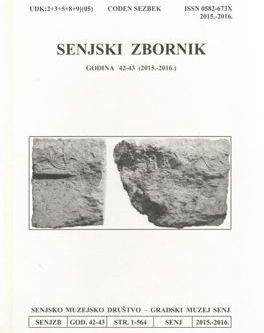Katedrala Uznesenja Blažene Djevice Marije u Senju i senjski biskupi do početka XVII. stoljeća (prilog cjelovitoj povijesti grada Senja)
Cathedral of The Assumption of the Blessed Virgin Mary in Senj and Senj bishops until the beginning of the 17th century
Author(s): Juraj LokmerSubject(s): Christian Theology and Religion, History, History of Church(es), Regional Geography, Local History / Microhistory
Published by: Senjsko muzejsko društvo i Gradski muzej Senj
Keywords: Senj cathedral; Senj diocese: Senj bishops; Senj;
Summary/Abstract: Senj was a diocese as early as beginning of the 5th century, when Senj’s bishops Laurencia and Maximinus are mentioned. There probably exited a cathedral for these bishops which only archaeological finds give a hint to. The first certain written source about the diocese of Senj is from 1169, which mentions the Bishop of Senj Miraeus. Over the centuries the cathedral experienced the fate of the town, its history is to a great extent the history of the town of Senj. The current cathedral is a restored building after the destruction in the Second World War (1943-1944). Some of its oldest parts date back to the 13th century, and maybe even earlier, which is evidenced by Late Antiquity finds (mosaics) in its immediate vicinity. In the 12th and 13th centuries the town was governed by the Knights Templar. In the great fire of 1239 the town was completely destroyed. At that time also damaged were the Templar Church of St George and the Miraeus Cathedral of St Mary, which appeared on a layer of ancient temples (Magna Mater and others) and an early Christian oratory. After that, Bishop Philip probably built a single-nave Romanesque cathedral with a moulded brick façade and lengthwise nave, along whose façade there also stood a rustic bell tower – fortress, whilst the bell tower of the old cathedral from 1000 (according to tradition) remained behind the apse of the Romanesque cathedral. Senj’s cathedral had been the cathedral of the glagolitic bishops since the time of Bishop Philip, who in 1248 gained the special right from Pope Innocent IV to use the old Slavic language and glagolitic script in the liturgy. Since before 1340 alongside the cathedral the Cathedral Chapter also operated, which from 1392 under a special right from Emperor Sigismund of Luxembourg became locus credibilis. After the Venetian destruction of the town in 1380 the cathedral was restored and reconstructed which can be seem by the preserved traces (the broken arch of the shrine), the tombstone of bishops Ivan and Leonard de Cardinalibus from 1392. Also bearing witness to that time are a small number of preserved silver items (a processional cross from the end of the 14th century and the beginning of the 15th). The Counts of Krk – the Frankopans, who from 1271 for almost 200 years governed the town as hereditary podesta, patrons of the diocese of Senj and Senj’s cathedral, bestowed the Senj Chapter with funds and properties. In the shadow of Senj’s cathedral there also worked the scriptorium in which Tomas, the archdeacon of Senj, wrote the glagolitic missal (1st Vrbnik missal) in 1456. In 1497 Bishop Andrija Campana de Mutina built the sacristy and acquired an organ, whilst Senj’s canons led by Blaž Baromić founded the printing house in 1491 which printed books in the glagolitic script all the way up to 1508 in the Church Slavonic and Croatian (Chakavian) language for use in the liturgy and spiritual care. The very few remains of the remarkable quality of goldsmith’s art of Senj’s goldsmiths, especially of the Živković family, bear witness to the wealth of the town and the life of its residents. At the end of the 15th century artists of the Apennine peninsula travelling to or from Buda worked in Senj and they left their mark in the cathedral (the relief of the Holy Trinity from 1491, the repository from the end of 15th century, the crucifix from the 16th century and the adjoining portal of the cathedral). Senj’s bishops of the 16th century worked at the time of Ottoman threats and internal struggles with the state, political and religious plan. They resolutely defended not only the rights of the Church and Chapter, which the military administration of the town endangered, but also their town from the Turks. Senj’s canons and Uskoks – defectors, who after the fall of Klis found shelter in Senj, led by Senj Bishop Antonio de Dominis in 1596 tried to liberate Klis and Dalmatia from the Turks, sacrificing his own life for it. Senj Bishop Marco Antonio de Dominis, theologian, scientist, politician, and adjudged later as a heretic by the Church came into conflict with the people of Senj and the Uskoks, left the town which had become a military camp. From the mid-16th century Senj’s bishops governed the Modruš diocese, and after the resettlement of the Uskoks from Senj at the beginning of the 17th century, the Senj and Modruš dioceses were united into a single diocese. Although quite rebuilt, added to and not rich with an inventory from its earliest times of its existence Senj’s cathedral is a true picture of not only the religious, church life of Senj but is in its own way a historical-spiritual icon of Croatia - Imago pietatis Croatiae.
Journal: Senjski zbornik - prilozi za geografiju, etnologiju, gospodarstvo, povijest i kulturu
- Issue Year: 43/2015
- Issue No: 1
- Page Range: 235-326
- Page Count: 91
- Language: Croatian

